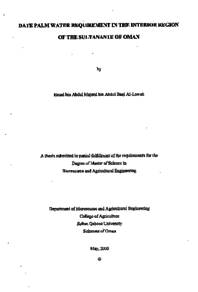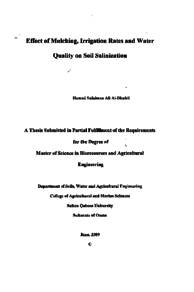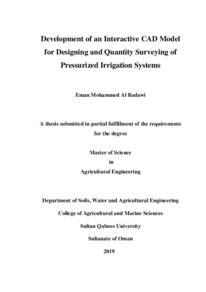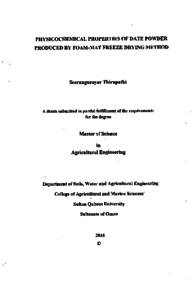Document
Date Palm Water Requirement in the Interior Region of the Sultanate of Oman
Publisher
Sultan Qaboos University
Gregorian
2000
Language
English
English abstract
Date palm is the most important crop in the Sultanate of Oman. It is widely distributed in the country, with the exception of the southern region of Dhofar. As water resources in the country are limited, there is a pressing need to assess the crop water requirements of this important crop under local conditions. This thesis presents the results of a study conducted at Al-Rafaa farm in Nizwa in Oman's interior. Plots of mature date palms (Khalas variety) were selected for the study. The soil-water balance method was used to estimate the temporal distribution of the crop coefficient of date palm under both modern and traditional irrigation systems. The study was accomplished using Time-Domain Reflectometry measurements of the soil-water content, a computerized irrigation scheduling package (SCS Scheduler), and meteorological data from an automated weather station at the site. The study produced baseline information on the crop water requirements of date palms in the interior region of Oman under both types of irrigation systems.
The study demonstrated that annual evapotranspiration for date palms (ET.) under the traditional falaj irrigation system was higher by 18.6% compared to the modern bubbler irrigation system. The annual ETC under the traditional falaj system was 2647 mm while the ET, under the bubbler irrigation system was 2232 mm. The average daily ETC was 7.25 mm and 6.11 mm for date palm trees under the traditional and bubbler irrigation systems, respectively.
The temporal crop coefficient curves generated in this study show little difference under the two systems. The basal crop coefficient ranges from 0.9 to 1.44 for date palm trees under the bubbler irrigation system and 1.03 to1.55 under the traditional system. The difference can be attributed to the way the two systems were managed. The increased evaporation from the soil surface under the traditional system, in which the entire surface is wetted, contributes to the observed increase in water use. Moreover, weeds tend to grow over the entire area under traditional irrigation while they are limited to the basins of the trees under bubbler irrigation. This will increase the overall water use efficiency of the modern system compared to the falaj system.
The wet-dry irrigation cycle practiced in the traditional falaj system enhanced date production, although the dates produced under the bubbler system were of better quality. While it is inconclusive to rely on only one season to make definite conclusions on the production of dates, it should be pointed out that the average production of dates under the traditional irrigation system was 80.9 kg/tree while it was 60.5 kg/tree under the bubbler system. This could be due to the excess water used under the traditional system since the water use efficiency under the bubbler irrigation system was high compared to that of the traditional system.
The soil water regime under the traditional falaj system shows that the soil water exceeded the field capacity during irrigation with an excess irrigation of 336 mm for the whole year. However, the soil moisture dropped below the management allowable depletion level of 60% before irrigation. On the other hand, t1 regime under the bubbler irrigation system shows less fluctuations and very limited excess of irrigation.
Member of
Resource URL
Arabic abstract
تعتبر شجرة نخيل التمر أهم محصول في سلطنة عمان فهي منتشرة في جميع مناطق السلطنة باستثناء محافظة ظفار. وتأتي أهمية تقدير الاحتياجات المائية للنخيل تحت الظروف الطبيعية من حيث محدودية مصادر المياه في السلطنة. يبين البحث نتائج الدراسة التي تم إجراؤها في مزرعة الرفع في ولاية نزوى في المنطقة الداخلية حيث تم تجهيز قطعتين تحتوي كل منها على أشجار نخيل كاملة النضج من نوع خلاص. تم إتباع طريقة حساب الميزان المائي للتربة لتقدير معامل النبات للنخيل تحت نظام الري الحديث والتقليدي و تم إجراء الدراسة عن طريق أخذ القراءات باستخدام جهاز TDR لحساب المحتوى المائي التربة و برنامج للجدولة عن طريق الحاسب الآلي وتزويده بالبيانات المناخية من محطة الأرصاد الآلية التي تم تركيبها في المزرعة. أنتجت الدراسية معلومات أساسية خاصة بالاحتياجات المائية الفعلية لأشجار نخيل التمر تحت نظام الري التقليدي والحديث في المنطقة الداخلية.
أوضحت الدراسة أن التقدير الفعلي السنوي للبخر - نتح (ET) لأشجار نخيل التمر تحت نظام الفلج التقليدي اكبر بحوالي ۱۸٫6% منه تحت نظام الري الحديث النافورة)، حيث تبين أن البخر - نتح الفعلي تحت نظام الري التقليدي يساوي ۲۹47 ملم - السنة في حين يساوي ۲۲۳۲ ملم السنة تحت نظام الري بالنافورة. وكان المعدل اليومي للبخر - نقع الفعلي يساوي ۷٫۲۰ ملم و 6 , ۱۱ ملم لأشجار نخيل التمر
تحت نظام الري التقليدي و نظام الري بالنافورة، على التوالي. وأوضحت الدراسة أن الفارق في تقديرات معامل النبات تحت نظام الري التقليدي والحديث بسيط. فقد تراوح معامل النبات الأشجار النخيل تحت نظام الري بالنافورة من 9،. إلى 1٬44 في حين تراوح من ۲۰۰۳ إلى ۱ , ۰۰ تحت نظام الري التقليدي. وقد تبين أن نظام الري يحدث تأثيرا بسيطا على معامل النبات. ويعزى الفرق في اختلاف تقدير معامل النبات تحت نظامي الري إلى إدارة مياه الري، حيث أدي ري المساحات البينية في نظام الري التقليدي إلى زيادة التبخر من سطح التربة مما نتج عنه زيادة في استخدام مياه الري. بالإضافة إلى ذلك فإن نمو الأعشاب في المساحات البينية في نظام الري التقليدي كان كبيرا، في حين أن نمو الأعشاب كان محدودا في حوض النخلة تحت نظام الري بالنافورة والذي أدى في النهاية إلى رفع كفاءة استخدام المياه تحت نظام الري بالنافورة. أن تعاقب فترات الجفاف والرطوبة بسبب نظام الري المتبع في الافلاج أدى إلى إنتاج ثمار ذات خواص فيزيائية متدنية مقارنة بالإنتاج تحت نظام الري بالنافورة. كان معدل إنتاج النخلة تحت نظام الري التقليدي كبيرا (۸۰ ، ۹ كغم النخلة) في حين كان معدل إنتاج النخلة تحت نظام الري بالنافورة اقل (۹۰ ، ۰ كغم/النخلة). وقد يعزى السبب في ذلك إلى استخدام كميات مياه إضافية تحت نظام الري التقليدي. ومع ذلك، فإن كفاءة استخدام مياه الري كانت أعلى تحت نظام الري بالنافورة مقارنة بنظام الري التقليدي. مع العلم أنه لا يمكن الأخذ بها كتوصية نهائية بسبب إجراء التجربة لموسم واحد.
إن النظام المائي للترية تحت نظام الفلج التقليدي اظهر أن المحتوى المائي للتربة تجاوز السعة الحقلي خلال الري وبزيادة في كمية المياه المستخدمة قدرها ۳۳۹۶ ملم/ السنة، في حين أن المحتوى المائي التربة انخفص ليصل إلى أقل من المستوى المائي المنظم عند ۹۰% وذلك قبل الري. ومن ناحية أخرى، فان النظام المائي للتربة تحت نظام الري الحديث اظهر تذبذبا اقل و زيادة محدودة في كميات مياه الري المستخدمة.
أوضحت الدراسة أن التقدير الفعلي السنوي للبخر - نتح (ET) لأشجار نخيل التمر تحت نظام الفلج التقليدي اكبر بحوالي ۱۸٫6% منه تحت نظام الري الحديث النافورة)، حيث تبين أن البخر - نتح الفعلي تحت نظام الري التقليدي يساوي ۲۹47 ملم - السنة في حين يساوي ۲۲۳۲ ملم السنة تحت نظام الري بالنافورة. وكان المعدل اليومي للبخر - نقع الفعلي يساوي ۷٫۲۰ ملم و 6 , ۱۱ ملم لأشجار نخيل التمر
تحت نظام الري التقليدي و نظام الري بالنافورة، على التوالي. وأوضحت الدراسة أن الفارق في تقديرات معامل النبات تحت نظام الري التقليدي والحديث بسيط. فقد تراوح معامل النبات الأشجار النخيل تحت نظام الري بالنافورة من 9،. إلى 1٬44 في حين تراوح من ۲۰۰۳ إلى ۱ , ۰۰ تحت نظام الري التقليدي. وقد تبين أن نظام الري يحدث تأثيرا بسيطا على معامل النبات. ويعزى الفرق في اختلاف تقدير معامل النبات تحت نظامي الري إلى إدارة مياه الري، حيث أدي ري المساحات البينية في نظام الري التقليدي إلى زيادة التبخر من سطح التربة مما نتج عنه زيادة في استخدام مياه الري. بالإضافة إلى ذلك فإن نمو الأعشاب في المساحات البينية في نظام الري التقليدي كان كبيرا، في حين أن نمو الأعشاب كان محدودا في حوض النخلة تحت نظام الري بالنافورة والذي أدى في النهاية إلى رفع كفاءة استخدام المياه تحت نظام الري بالنافورة. أن تعاقب فترات الجفاف والرطوبة بسبب نظام الري المتبع في الافلاج أدى إلى إنتاج ثمار ذات خواص فيزيائية متدنية مقارنة بالإنتاج تحت نظام الري بالنافورة. كان معدل إنتاج النخلة تحت نظام الري التقليدي كبيرا (۸۰ ، ۹ كغم النخلة) في حين كان معدل إنتاج النخلة تحت نظام الري بالنافورة اقل (۹۰ ، ۰ كغم/النخلة). وقد يعزى السبب في ذلك إلى استخدام كميات مياه إضافية تحت نظام الري التقليدي. ومع ذلك، فإن كفاءة استخدام مياه الري كانت أعلى تحت نظام الري بالنافورة مقارنة بنظام الري التقليدي. مع العلم أنه لا يمكن الأخذ بها كتوصية نهائية بسبب إجراء التجربة لموسم واحد.
إن النظام المائي للترية تحت نظام الفلج التقليدي اظهر أن المحتوى المائي للتربة تجاوز السعة الحقلي خلال الري وبزيادة في كمية المياه المستخدمة قدرها ۳۳۹۶ ملم/ السنة، في حين أن المحتوى المائي التربة انخفص ليصل إلى أقل من المستوى المائي المنظم عند ۹۰% وذلك قبل الري. ومن ناحية أخرى، فان النظام المائي للتربة تحت نظام الري الحديث اظهر تذبذبا اقل و زيادة محدودة في كميات مياه الري المستخدمة.
Category
Theses and Dissertations





